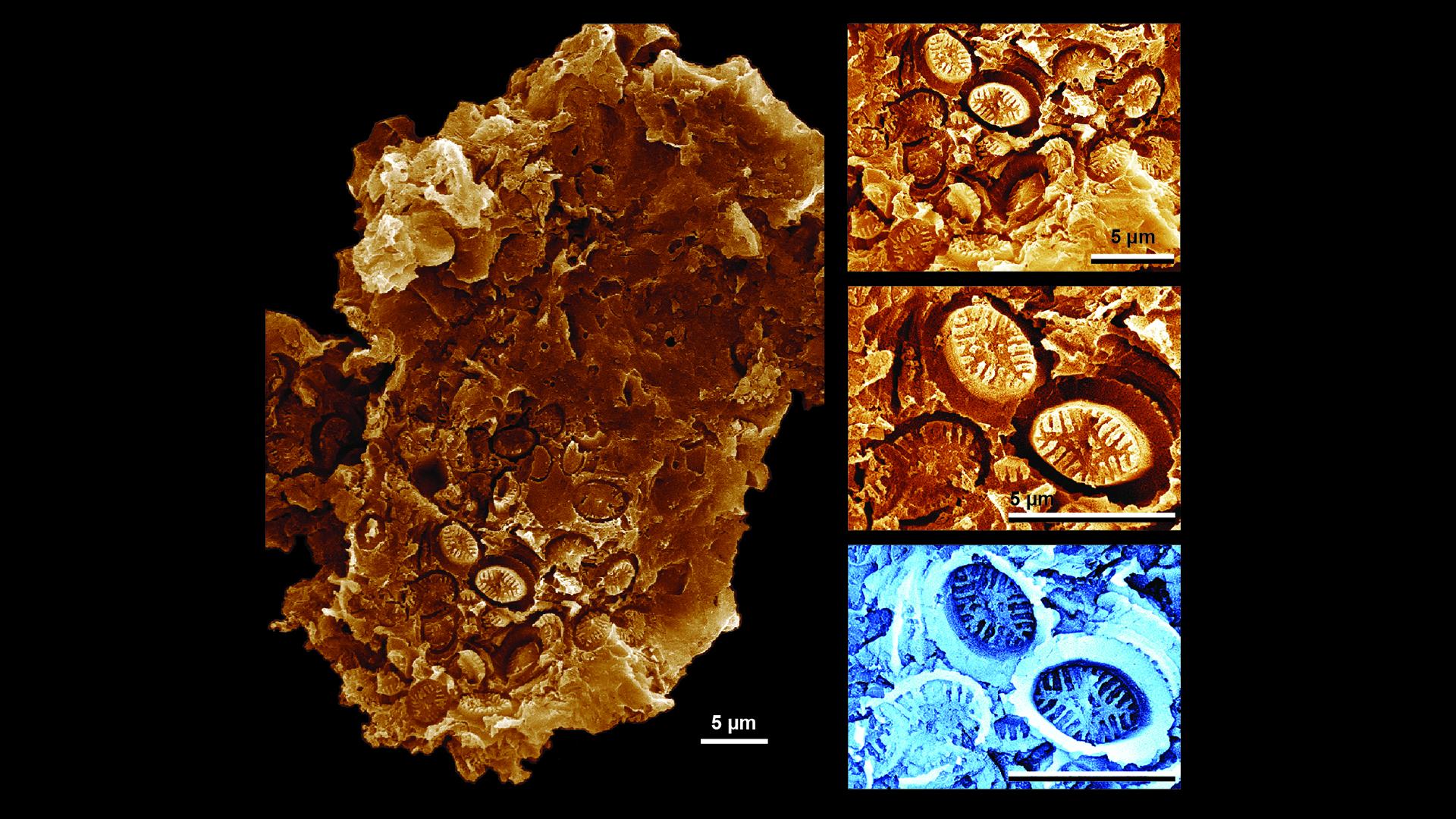'Ghost' fossils preserve haunting record of ancient life on a hellish Earth
Geometric fossils in marine sediments have a story to tell.

Ghostly imprints of tiny plankton-like creatures have been found haunting the sediments of prehistoric oceans at a time when such organisms were thought to be extinct. The so-called nannofossil imprints reveal that the organisms survived acidic oceans caused by climate change, and could offer a clue for how modern creatures can endure rising ocean temperatures, researchers said.
Nannofossils are the remains of marine plankton called coccolithophores (cox-oh-LITH'-oh-fours), which belong to the class Prymnesiophyceae and still exist today at the bottom of many ocean food chains. Each of these single-celled, algae-like organisms measures less than 0.001 inch (30 micrometers) wide, and is surrounded by a hard layer of geometric calcium scales, according to the Faculty of Geosciences at the University of Bremen in Germany. And these nannofossils are incredibly abundant.
"There are way, way more nannofossils than any other kind of fossils," Paul Bown, a micropaleontologist at University College London, U.K., and co-author of the new study, told Live Science. "It means we can really be statistically robust, because we see so many of them."
When these tiny plankton die, they sink to the seafloor, where their calcium shells slowly accumulate. Over time, these piles of white mineralized scales, known as coccoliths, are pressed together to form walls of chalk. A classic example, according to Brown, is the famous White Cliffs of Dover in England. "The white chalk cliffs are white because they’re almost 100% nannofossils," Bown said.
Related: We finally know how trilobites mated, thanks to new fossils
However, there are points in the fossil record where coccolithophores appear to suddenly vanish, only to return mysteriously millions of years later. "You get these abrupt changes in the sediment where you go from almost pure white sediments into black sediments," Bown said. These points coincide with ancient ocean warming events, during which seawater became more acidic as it reacted with increased carbon dioxide from the atmosphere. As ocean pH dropped during these events, it ate away at the coccolithophores' calcium shells, much like vinegar can dissolve an eggshell, according to research from the National Oceanic and Atmospheric Administration (NOAA).
Scientists once thought that most species of calcium-coated plankton in these acidic seas were wiped out en masse multiple times and replaced by non-shelled species, whose bodies decomposed into dark, sludgy goop and later hardened into rock.
Get the world’s most fascinating discoveries delivered straight to your inbox.
Bown's co-author Sam Slater, a micropaleontologist at the Swedish Museum of Natural History in Stockholm, previously concluded much the same. But then Slater noticed something strange during research for another study seeking traces of ancient pollen, while examining black sediments from a warming event during the Jurassic period (201 million to 145 million years ago). Under a powerful microscope, Slater detected tiny geometric imprints in the rock, and he realized that these imprints were shaped exactly like coccolithophores.
Slater reached out to Bown and a handful of other specialists to help investigate. Sure enough, the rock was stamped with coccolithophores. "These were spectacularly preserved impressions," Bown said."I could identify these things down to the species level."
Intrigued by this discovery, the researchers then examined fossil sediments from other Jurassic sites around the world, as well as samples from two warming events during the Cretaceous period (145 million to 66 million years ago). "And we found these impressions, these ghost fossils, wherever we looked," Bown said.
These results suggest that, contrary to previous research, some coccolithophores survived catastrophic ocean acidification and warming die-offs, even as other species went extinct. But the low ocean pH dissolved their shells posthumously, erasing them from the fossil record.
This information could help shed light on our current climate catastrophe, the researchers said, which is already eating away at calcium-rich coral reefs, according to Smithsonian. If the coccolithophores can adapt to warmer, more acidic conditions, it may be good news for modern creatures further up the food chain.
However, Bown warns against equating ancient warming events too closely with modern climate change, which is happening at roughly 10 times the rate of previous catastrophes, according to research published in 2019 in the journal Paleoceanography and Paleoclimatology.
"It's a cautionary tale," Bown said, "And you have to be careful how you go and read the rocks."
The new study was published May 19 in the journal Science.
Originally published on Live Science.

Joanna Thompson is a science journalist and runner based in New York. She holds a B.S. in Zoology and a B.A. in Creative Writing from North Carolina State University, as well as a Master's in Science Journalism from NYU's Science, Health and Environmental Reporting Program. Find more of her work in Scientific American, The Daily Beast, Atlas Obscura or Audubon Magazine.



